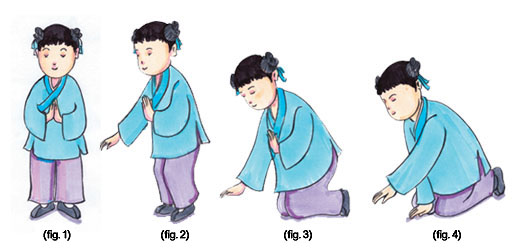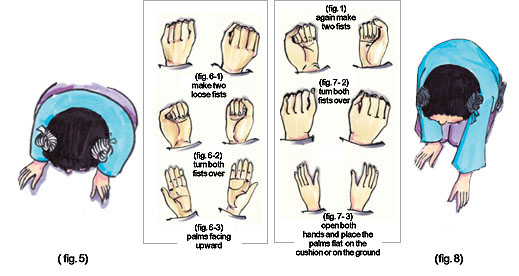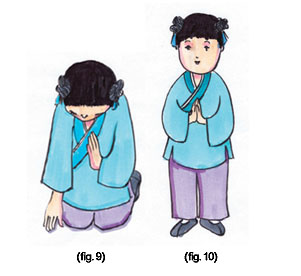| |
| ◎
Buddhist Rituals and Observances│1│2│3│4│ |
|
D.
Learning How to Pay Homage to the Buddhas in an Easy and Relaxing Manne
(A) The Significance of Paying Homage
To pay homage is to express our respect and gratitude
to the Triple Gem of the Buddha, the Dharma and the Sangha. It is to examine
and repent our misdeeds in order to elevate our character and gain peace
and ease in our body and mind.
In paying homage to the Buddhas, our movement must be sincere and respectful—to
sincerely and reverently put our palms together, bow our head, bend our
waist and prostrate. By touching our elbows, knees and forehead on the
ground, we have completed the gesture of showing the highest deference
to the Buddha in touching his feet. By bowing our head and bending our
waist, we recognize our lack of merit and wisdom. In making contact with
the ground in prostration, we are inspired by the spirit of the earth
in forbearing everything and providing nutrients and sustenance to all
sentient beings. Therefore, it is imperative for us to be grateful for
the benefits bestowed by the earth and all sentient beings.
From the gesture of paying homage to the Buddhas, we are reminded of
the wheat stalk, how its ears are bent downward when the grains ripen.
Hence, when our heart is filled with respect, gratitude and repentance
in every movement of the prostration, we understand perfectly the meaning
and significance of paying homage to the Buddhas.
(B) Prostration—a Step-by-Step
Illustration
1.·
Stand upright and press your palms together, with heels two inches apart
and toes pointing outward, leaving a distance of approximately eight inches
between the tips of the feet, and focus your eyes on the two middle fingers
(see fig. 1).
2.· Lower the right hand
first, while keeping the left hand in its position as described in the
previous step. Slowly bend your knees with the right arm extended towards
the ground (see fig. 2); place the right
palm in the middle of the prostration cushion or in front of the right
knee, and promptly bend both knees, while the left palm remained unmoved
(see fig. 3). After kneeling down on the cushion or on the ground,
extend the left arm and place the left palm in the middle of the cushion,
slightly to the left, or in front of the right knee, also slightly to
the left, half-a-palm length ahead of the right hand (see
fig. 4). The tips of the feet must not move or turn while making
the prostration.
3.· Move the right palm
slightly forward from its position in the middle of the prostration cushion
or in front of the right knee by half-a-palm length, so it is even with
the left palm. The distance between the two palms should be about six
inches apart. Then, place your forehead flat on the cushion or on the
ground (see fig. 5).
4.· Make two loose fists
(see fig. 6-1), turn them over, so the fists face upward (see
fig. 6-2); open both fists with the palms up and the back of the
hands laying flat on the cushion or on the ground (see
fig. 6-3). This is known as “the complete prostration of receiving
the feet of the Buddha with the forehead.” When making this gesture, it
is important that we touch the cushion or the ground with your forehead
and not the top of your head.
5.· When standing up, make
the fists again, turn them over, so the fists are now facing the cushion
or the ground (see fig. 7-1, 2); open both
hands with the center of the palms pressing down flat on the cushion or
on the ground (see fig. 3); lift your forehead
off the cushion or the ground, and move the right hand back to the middle
of the cushion or in front of the right knee (see
fig. 8).
6.· Raise the left hand
back to chest high and use the right hand as leverage to prop up your
body (see fig. 9), then straighten your waist
and stand upright with both palms pressed together (see
fig. 10).
 |
 |
 |
|
|











